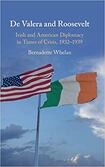
Éamon de Valera and Franklin D Roosevelt first met in 1919. De Valera was on his 18-month US tour seeking recognition for the Irish Republic and floating a Dáil Éireann loan. He needed advice as to the legality of the bond certificates. Roosevelt was a partner in the New York law firm of Emmet, Marvin and Martin and was chosen because he had no connection with Irish America and his opinion would therefore be unbiased.
Roosevelt went on to become US president from 1933 to 1945. De Valera was head of government in Dublin for all of those years. He followed US affairs with great interest and not only because he had been born in New York. Politically he was determined to keep Irish-American republicanism under his own control and he was also convinced that America was a unique source of political, moral and financial assistance to Ireland. Thus his visits to America in 1927, 1929 and 1930. He never met Roosevelt again after their 1919 encounter but they probably had more dealings with one another than any other head of government in Dublin and US president.
In this account of the contacts between Washington and Dublin in the 1930s Prof Whelan has provided a background to the issues of the day and a detailed insight into the activities of both US and Irish diplomats. The US established a legation in Dublin in 1927 and for the first seven years it was headed by a career diplomat, Frederick Sterling. Subsequently, heads of US missions in Dublin have been political appointees. Ireland established its legation in Washington in 1924 and from the beginning it has been headed by career diplomats.
It fell to these diplomats to manage the relationship between the two new leaders and to deal with the day-to-day issues such as migration, trade and the purchase of arms. While the US president frequently expressed a high regard for de Valera, describing him as a “great personality and a wise statesman”, this did not translate into any special treatment for Ireland. Irish diplomats in Washington realised that the Anglo-American relationship was the real “special relationship” and that no lobbying from Ireland would influence US-UK links in Ireland’s favour.
De Valera did not accept this and stubbornly clung to his own view that the Americans sympathised with the case for “Irish unity”. The US minister John Cudahy, who was in Dublin from 1937 to 1940 and had an unusually close relationship with de Valera, tried but failed to disabuse him of his view. This relationship may incidentally have contributed to de Valera’s view that he had more influence with Roosevelt than the reality.
De Valera continued to idealise the US-Irish relationship and believed in the willingness and desire of American politicians to assist with the Irish question. On the eve of the 1938 Anglo-Irish talks he stressed to Cudahy that America must support the Irish position [on unity] because of its “inherent injustice, the sympathy of American public opinion and the significance for world peace of friendly Irish-British relations”.
He also sought the involvement in the talks of the newly appointed US ambassador in London, Joseph P Kennedy. He said that Kennedy along with Roosevelt himself could be of “great aid” to Ireland in dealing with the British. American interest and involvement in the talks was not, as Whelan documents in detail, significant, though that did not stop de Valera when the talks had ended writing to thank Roosevelt for his intervention which, he said, had helped break the deadlock.
Prof Whelan provides fascinating detail about the day-to-day activities of the diplomats. In addition to the legation in Washington Ireland had consulates in New York, Boston, Chicago and San Francisco, all of which were established in the 1930s. They were staffed by inexperienced career diplomats who were very poorly resourced and given little guidance from headquarters in Dublin. Overall one can only marvel at their generally excellent performance. They contributed hugely to the assertion of Irish sovereignty, managed the tricky task of keeping good relations with all elements of a politically divided Irish-American community and developed good contacts with the relevant political people in Washington, including those in the Anglophile state department.
The US diplomats in Ireland had a considerably easier time. They undoubtedly had less work and were well staffed and resourced in their offices in Belfast, Cork and Galway as well as the legation in Dublin. They enjoyed easy access to senior political figures and to the civil service. Some of them took full advantage of the hunting, shooting and fishing opportunities which Ireland offered. As noted already, Cudahy, who was the envoy from 1937 to 1940, was particularly close to and helpful to de Valera, in marked contrast to his successor David Gray, related by marriage to Eleanor Roosevelt, and appointed to Dublin in 1940.
Prof Whelan has in this book given us much detail and analysis about US-Ireland official contacts in the 1930s, a frequently neglected period. She has also thrown valuable light on the development of the young Irish diplomatic service. In doing so she has enhanced her reputation as the leading historian of the relationship between the US and Irish Governments.
Seán Donlon is a former Irish Ambassador in the US








